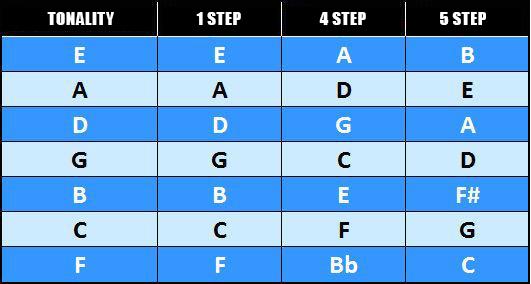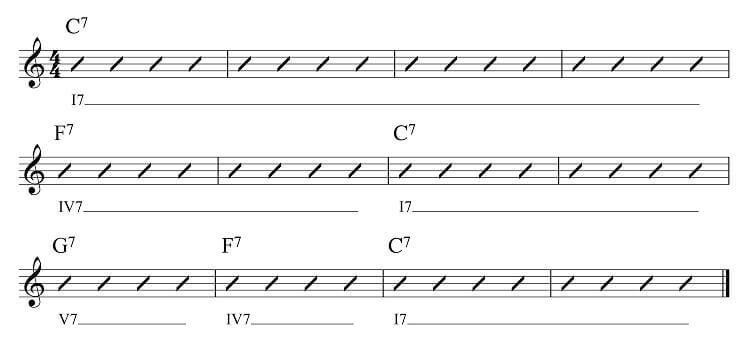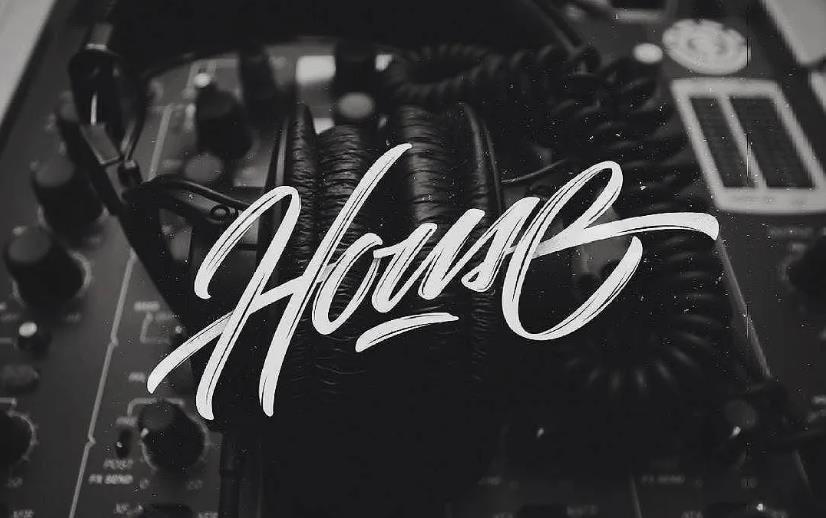什么是 1-IV-V 布鲁斯和弦进行

在I,IV和V和弦上建立的12杆布鲁斯进度是多种流派的无数歌曲的骨干。它可以立即通过其节奏和结构来识别,一旦您将其放下,您就可以轻松地跳入果酱会话或开始写自己的音乐。即使您不是音乐家,而是享受摇滚,蓝调,爵士乐,放克或国家 - 很有可能,您也听到了这种行动进展的次数,超出了您的意识。
I – IV -V的核心基于主要规模的特定步骤使用三个和弦。例如,在E专业的钥匙中,这些和弦是E(i),A(iv)和B(v)。这些和弦遵循一个12个量的周期,每种措施都有一个目的 - 从建立钥匙到建立紧张,再到解决它。因此,音乐家确切地知道他们在歌曲中的位置以及下一步将要发生的事情。
一旦学习了一个键,就可以轻松地将其转换为任何其他键。在支持歌手或切换乐器时,这特别有用。除了12杆蓝调外,I – IV-V结构还出现在其他许多进步中,因此熟悉它为了解现代音乐的运作方式打开了大门。

如果您刚刚开始 - 也许学习吉他或进入音乐理论 - 和弦生成器可能是一个超级有用的工具。它向您展示了12杆形式的外观不同的钥匙,并向您介绍了诸如占主导地位的七分之一,传递和弦或更多蓝调扩展的变化,从而使其具有标志性的风味。
您会发现数百首歌曲中的I – IV -V进行,从经典的布鲁斯到现代流行歌曲。吉他手特别喜欢它,因为它自然而然地适合指板,并使独奏感觉直观。一旦将其放在手指下,您就可以识别和弦图案,用耳朵建立自己的伴奏,并在与他人一起玩时感到更加自信。
要将其全部锁定,请尝试分解一些使用此进步的歌曲,然后练习将它们转换为不同的键。这是提高您的技术并对音乐如何流动的真实,努力理解的好方法。
蓝色I – iv -V的进展与主要版本有何不同
乍一看,蓝色I – IV -V的进展看起来就像是标准的大弦序列,但听起来完全不同。关键区别是使用的和弦类型。在像C这样的主要钥匙中,您通常会看到CMAJ7,FMAJ7和G7。在蓝调中,是C7,F7和G7 - 占主导地位的第七和弦,增加了毅力和张力。
这违背了传统的和谐规则,但这正是使布鲁斯签名的感觉。另一个重要方面是节奏。蓝调经常使用秋千或洗牌凹槽,并增加了悠闲的“推和拉”氛围。
因此,尽管结构保持不变,但蓝色I – IV – V具有自己的声音 - 原始,表现力和明确的蓝调。

在蓝调中,我们仍然使用主要规模的第一,第四和第五度 - 在C的钥匙中,即C,F和G。但代替标准的主要和弦而不是标准的主要和弦,每个和弦都变成了占主导地位的第七个。因此,我们获得了C7,F7和G7。这增加了第七次和弦,即使是在补品上,和弦也使他们的标志性紧张和咬合。

蓝调的进展遵循一个12杆形式,并具有半固定的和弦布局。 C7将酒吧1至4固定在4-8的酒吧中,然后在酒吧11-12中再次出现。 F7出现在5-6条中,再次出现在第10条中。G7仅出现在BAR 9中。
这种熟悉的模式为布鲁斯措辞和即兴创作奠定了基础。表面上很简单,但这是无数蓝调轨道和果酱会议背后的基础。

弹奏吉他的进展,以使您的耳朵和手指下的三个主流第七和弦发出声音。这将有助于您真正锁定12杆形式的感觉,然后再潜入一些众所周知的蓝调音乐中。
I -IV – V进度构建的10首布鲁斯歌曲
为了真正了解I -IV -V Blues的进步如何在实际音乐中起作用,它有助于听取前部和中心的歌曲。下面是十个曲目的列表,它们要么与经典的12杆形式紧密相关,要么在其上具有轻微的变化。这些歌曲中的一些最初是由早期的布鲁斯先驱者录制的,但通过后期的封面广为人知 - 这两个版本都值得一看,以听取不同的艺术家如何解释相同的核心结构。
- 十字路口 - 奶油 /罗伯特·约翰逊(Robert Johnson);
- 除尘我的扫帚——埃尔莫·詹姆斯;
- 暴风雨星期一——丁骨行者;
- 德克萨斯州洪水——史蒂维·雷·沃恩;
- 甜蜜的家芝加哥 - 好友盖伊 /罗伯特·约翰逊;
- 红房子——吉米·亨德里克斯;
- 我不能退出你的宝贝 - LED齐柏林飞艇 / Otis Rush;
- Boom Boom——约翰·李·胡克;
- CC骑手 - Mitch Ryder / Ma Rainey;
- 黑魔法女人——弗利特伍德麦克。
这些曲目中的每一个都提供了I -IV – V框架的不同风味 - 从坚韧的三角洲蓝调到电动芝加哥氛围。仔细聆听这些进步的使用方式将使您对自己的演奏或写作的形式和激发想法有着扎实的感觉。










